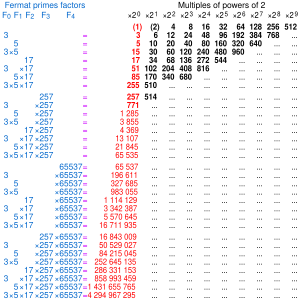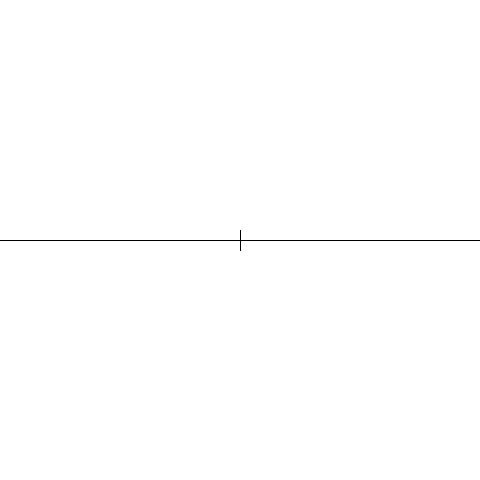Constructible polygon

In
Conditions for constructibility


Some regular polygons are easy to construct with compass and straightedge; others are not. The ancient Greek mathematicians knew how to construct a regular polygon with 3, 4, or 5 sides,[1]: p. xi and they knew how to construct a regular polygon with double the number of sides of a given regular polygon.[1]: pp. 49–50 This led to the question being posed: is it possible to construct all regular polygons with compass and straightedge? If not, which n-gons (that is, polygons with n edges) are constructible and which are not?
A full proof of necessity was given by
In order to reduce a
Detailed results by Gauss's theory
Restating the Gauss–Wantzel theorem:
- A regular n-gon is constructible with straightedge and compass if and only if n = 2kp1p2...pt where k and t are non-negative integers, and the pi's (when t > 0) are distinct Fermat primes.
The five known
Since there are 31 nonempty subsets of the five known Fermat primes, there are 31 known constructible polygons with an odd number of sides.
The next twenty-eight Fermat numbers, F5 through F32, are known to be composite.[3]
Thus a regular n-gon is constructible if
- n = ),
while a regular n-gon is not constructible with compass and straightedge if
- n = ).
Connection to Pascal's triangle
Since there are 5 known Fermat primes, we know of 31 numbers that are products of distinct Fermat primes, and hence 31 constructible odd-sided regular polygons. These are 3, 5, 15, 17, 51, 85, 255, 257, 771, 1285, 3855, 4369, 13107, 21845, 65535,
General theory
In the light of later work on
In the specific case of a regular n-gon, the question reduces to the question of constructing a length
- cos 2π/n ,
which is a
- ½ φ(n),
where φ(n) is Euler's totient function. Wantzel's result comes down to a calculation showing that φ(n) is a power of 2 precisely in the cases specified.
As for the construction of Gauss, when the Galois group is a 2-group it follows that it has a sequence of subgroups of orders
- 1, 2, 4, 8, ...
that are nested, each in the next (a
- cos 2π/17 .
Each of those is a root of a quadratic equation in terms of the one before. Moreover, these equations have real rather than complex roots, so in principle can be solved by geometric construction: this is because the work all goes on inside a totally real field.
In this way the result of Gauss can be understood in current terms; for actual calculation of the equations to be solved, the periods can be squared and compared with the 'lower' periods, in a quite feasible algorithm.
Compass and straightedge constructions
- If p = 2, draw a q-gon and bisect one of its central angles. From this, a 2q-gon can be constructed.
- If p > 2, inscribe a p-gon and a q-gon in the same circle in such a way that they share a vertex. Because p and q are coprime, there exists integers a and b such that ap + bq = 1. Then 2aπ/q + 2bπ/p = 2π/pq. From this, a pq-gon can be constructed.
Thus one only has to find a compass and straightedge construction for n-gons where n is a Fermat prime.
- The construction for an equilateral triangle is simple and has been known since antiquity; see Equilateral triangle.
- Constructions for the regular pentagon were described both by Euclid (Elements, ca. 300 BC), and by Ptolemy (Almagest, ca. 150 AD).
- Although Gauss proved that the regular 17-gon is constructible, he did not actually show how to do it. The first construction is due to Erchinger, a few years after Gauss' work.
- The first explicit constructions of a regular 257-gon were given by Magnus Georg Paucker (1822)[5] and Friedrich Julius Richelot (1832).[6]
- A construction for a regular 65537-gon was first given by Johann Gustav Hermes (1894). The construction is very complex; Hermes spent 10 years completing the 200-page manuscript.[7]
Gallery




From left to right, constructions of a 15-gon, 17-gon, 257-gon and 65537-gon. Only the first stage of the 65537-gon construction is shown; the constructions of the 15-gon, 17-gon, and 257-gon are given completely.
Other constructions
The concept of constructibility as discussed in this article applies specifically to
A regular polygon with n sides can be constructed with ruler, compass, and angle trisector if and only if where r, s, k ≥ 0 and where the pi are distinct Pierpont primes greater than 3 (primes of the form [8]: Thm. 2 These polygons are exactly the regular polygons that can be constructed with Conic section, and the regular polygons that can be constructed with paper folding. The first numbers of sides of these polygons are:
- 3, 4, 5, 6, 7, 8, 9, 10, 12, 13, 14, 15, 16, 17, 18, 19, 20, 21, 24, 26, 27, 28, 30, 32, 34, 35, 36, 37, 38, 39, 40, 42, 45, 48, 51, 52, 54, 56, 57, 60, 63, 64, 65, 68, 70, 72, 73, 74, 76, 78, 80, 81, 84, 85, 90, 91, 95, 96, 97, 102, 104, 105, 108, 109, 111, 112, 114, 117, 119, 120, 126, 128, 130, 133, 135, 136, 140, 144, 146, 148, 152, 153, 156, 160, 162, 163, 168, 170, 171, 180, 182, 185, 189, 190, 192, 193, 194, 195, 204, 208, 210, 216, 218, 219, 221, 222, 224, 228, 234, 238, 240, 243, 247, 252, 255, 256, 257, 259, 260, 266, 270, 272, 273, 280, 285, 288, 291, 292, 296, ... (sequence A122254 in the OEIS)
See also
References
- ^ a b Bold, Benjamin. Famous Problems of Geometry and How to Solve Them, Dover Publications, 1982 (orig. 1969).
- ^ Gauss, Carl Friedrich (1966). Disquisitiones arithmeticae. New Haven and London: Yale University Press. pp. 458–460. Retrieved 25 January 2023.
- ^ Prime factors k · 2n + 1 of Fermat numbers Fm and complete factoring status by Wilfrid Keller.
- ISBN 978-1-118-07205-9.
- ^ Magnus Georg Paucker (1822). "Geometrische Verzeichnung des regelmäßigen Siebzehn-Ecks und Zweyhundersiebenundfünfzig-Ecks in den Kreis". Jahresverhandlungen der Kurländischen Gesellschaft für Literatur und Kunst (in German). 2: 160–219.
- S2CID 199545940.
- ^ Johann Gustav Hermes (1894). "Über die Teilung des Kreises in 65537 gleiche Teile". Nachrichten von der Gesellschaft der Wissenschaften zu Göttingen, Mathematisch-Physikalische Klasse (in German). 3. Göttingen: 170–186.
- JSTOR 2323624.
External links
- Duane W. DeTemple (1991). "Carlyle Circles and the Lemoine Simplicity of Polygonal Constructions". MR 1089454.
- Christian Gottlieb (1999). "The Simple and Straightforward Construction of the Regular 257-gon". S2CID 123567824.
- Regular Polygon Formulas, Ask Dr. Math FAQ.
- Carl Schick: Weiche Primzahlen und das 257-Eck : eine analytische Lösung des 257-Ecks. Zürich : C. Schick, 2008. ISBN 978-3-9522917-1-9.
- 65537-gon, exact construction for the 1st side, using the Quadratrix of Hippias and GeoGebra as additional aids, with brief description (German)





